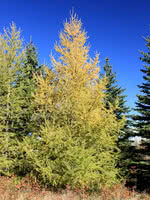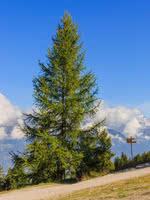Mon-Fri 9am - 5pm Mountain time
Siberian Larch vs European Larch
Larix sibirica
Larix decidua
NOT AVAILABLE THIS SEASON - MIGHT RETURN
Siberian Larch is a large, cold hardy conifer. Like the Tamarack, its needles turn golden yellow and drop in the fall, and it is able to handle saturated soils.
If you are looking for a long-lived tree for your large property or shelterbelt with quite wet soil, this is the tree for you.
This variety is often used on the south side of a shelterbelt to let sunlight in during the winter and to provide protection or shading during the summer.
The European Larch is a large deciduous conifer that, like most larches, drops its needles before winter. Known for the soft green foliage that turns a stunning golden yellow in the fall. While young, it has a pyramidal shape with horizontal branching and drooping branches, but becomes more irregular as it matures.
The European Larch is an important timber tree in Europe.

